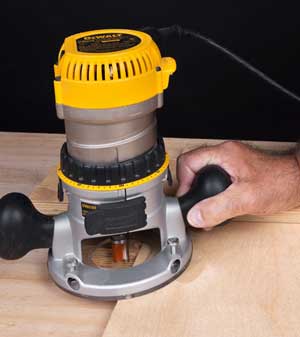
In order for a router to cut a straight line, the bit has to remain a fixed distance away from the edge of the router base and whatever you’re using as a clamped straightedge. Some routers have a flat edge on the base, which serves as an easy reference edge to guide the router along. Other routers, as you know, have round bases. On these machines, if your motor is even the slightest bit offset in the base – and not concentric within the round baseplate — even the slightest twist of the base against the straightedge during routing can send the bit off of its straight course. Here’s what I do to prevent that drifing from happening: I make a mark on the base with a permanent marker. Then, when I’m routing I keep the reference mark planted against the straightedge at all times. It keeps me from accidentally turning the router and ensures that even if my bit and base aren’t concentric, I’ll always get a perfectly straight cut.
– Chris Marshall





